AiPrise
14 mins read
July 18, 2025
AI Document Verification: Your Guide to Accuracy and Fraud Prevention
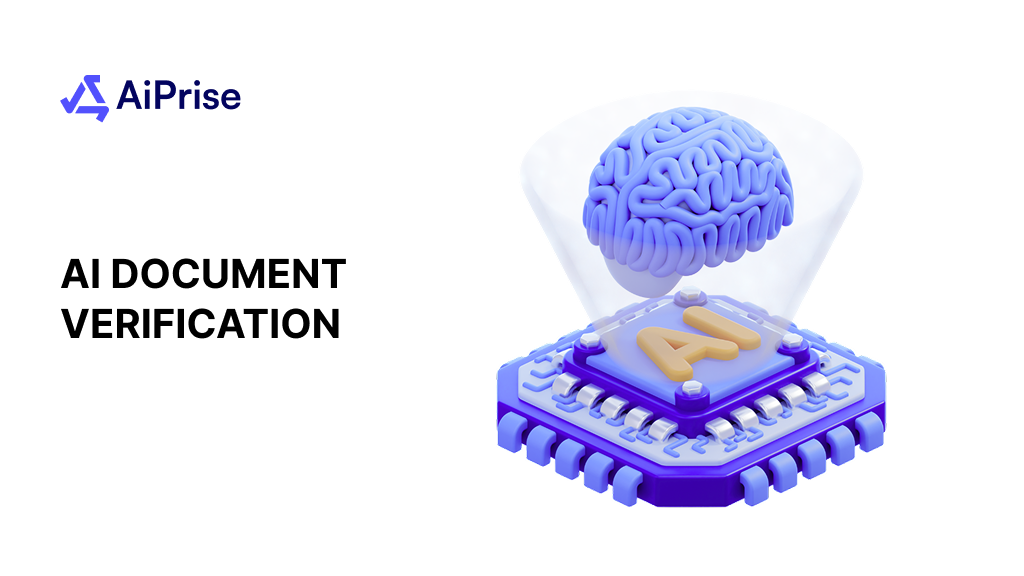
Key Takeaways










The document verification market is projected to reach USD 11.99 billion by 2034, driving businesses to adopt innovative solutions that meet evolving demands. AI-powered document verification is emerging as a key solution, offering businesses the ability to enhance speed, accuracy, and security while reducing operational costs.
With the increasing complexity of regulatory requirements and growing data volumes, these AI-driven solutions are becoming indispensable for companies aiming to stay competitive and efficient.
In this blog, you will explore how document verification using AI can help businesses improve workflows, streamline processes, and ensure compliance in an increasingly digital landscape.
TL;DR
- AI-driven document verification reduces fraud risks by quickly identifying discrepancies and ensuring accurate identity checks.
- Automated processes enhance compliance with KYC, KYB, and AML regulations, preventing errors and manual oversight.
- Red flags: Mismatched information, expired documents, inconsistent formats, and suspicious patterns.
- Solutions: Implement AI-powered document verification to streamline workflows, improve security, and ensure regulatory compliance.
What is AI Document Verification: Process and Core Components
AI document verification builds on the power of machine learning and pattern recognition to automatically assess and validate the authenticity of documents. This modern approach swiftly and accurately verifies identities, significantly reducing the risks of fraud and human error compared to traditional manual methods.
The system operates through a series of integrated steps, utilizing specialized components to ensure accuracy and efficiency:
- Intelligent Data Extraction (with OCR): AI systems employ Optical Character Recognition (OCR) and similar methods to accurately extract key information, such as text, images, and signatures, from scanned documents or PDFs.
- Robust Data Validation: The extracted data is then rigorously cross-checked against trusted databases, including government records, company databases, or third-party verified sources, to confirm its authenticity and consistency.
- Advanced Fraud Detection Algorithms: Sophisticated AI models, powered by machine learning algorithms, analyze document features like signatures, fonts, layouts, and security elements. They are designed to detect subtle signs of manipulation, alterations, or inconsistencies that indicate fraudulent activity.
- Real-Time Processing: Enabled by powerful cloud computing and optimized algorithms, the system processes documents instantly, providing immediate verification results without delays.
- Adaptive Learning: A core component of AI, machine learning models continuously improve their performance by learning from new data, recognizing emerging fraud patterns, and enhancing overall accuracy over time.
AI document verification enhances accuracy, efficiency, and security by automating data extraction and fraud detection. Understanding the benefits of this technology highlights its value in optimising your document verification process.
What are the Benefits of Document Verification Using AI?
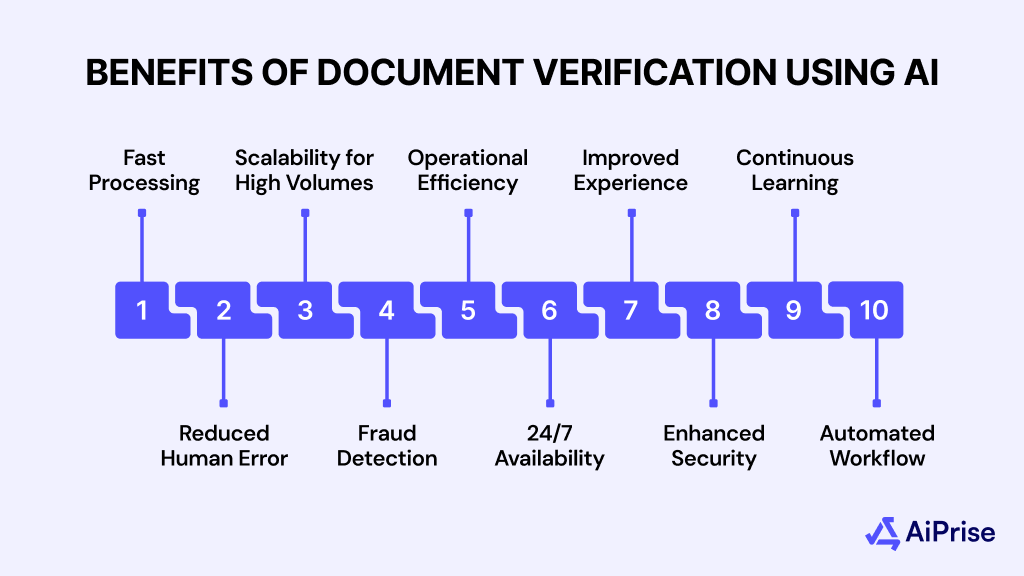
AI-powered document verification streamlines the verification process, reducing manual intervention and human error. It ensures quicker, more reliable assessments of document authenticity. By utilizing AI, businesses can improve operational consistency and enhance decision-making speed across their teams.
Here’s how AI document verification can benefit businesses:
Lightning-Fast Processing and Efficiency
AI radically accelerates the entire document verification process, eliminating human delays and enabling businesses to handle immense volumes with unprecedented efficiency.
- Automating data entry and validation frees up time for your team to focus on higher-priority tasks.
- Quicker document verification accelerates decision-making and enhances operational agility.
- AI ensures error-free verification, maintaining high accuracy across all documents.
Also Read: Why Speed Matters in Customer Onboarding
Superior Accuracy and Reduced Human Error
By removing the potential for human intervention and subjectivity, AI-driven document verification ensures consistently higher accuracy, significantly reducing costly mistakes and enhancing process reliability.
- AI’s rapid processing highlights discrepancies quickly, maintaining both speed and accuracy.
- Automating data entry and validation reduces the chances of mistakes and overlooked details.
- With fewer errors and corrections, your business saves both time and money in the long run.
Also Read: Why Manual Compliance Checks Are Outdated
Scalability for High Volumes
AI-powered document verification systems are inherently designed for scalability, seamlessly handling increasing volumes of documents without compromising speed, accuracy, or reliability.
- AI ensures fast verification, even as the volume of documents grows, preventing delays.
- Automating tasks allows you to process larger volumes without additional manual effort, reducing errors.
- No need for extra resources or infrastructure, allowing your team to focus on more critical tasks.
Advanced Fraud Detection
AI's sophisticated analytical capabilities provide a proactive edge in fraud detection, rapidly identifying inconsistencies and red flags that might otherwise be missed.
- AI scans and flags suspicious activity in real-time, preventing delays in the verification process.
- Early fraud detection reduces the risk of financial losses, reputational damage, and compliance issues.
- By preventing fraud, businesses build stronger relationships with clients, enhancing long-term stability.
Cost Savings and Operational Efficiency
By automating numerous manual tasks, AI-powered document verification drives significant cost savings and boosts overall operational efficiency.
- Automation speeds up verification, enabling quicker decisions and reducing the time spent on manual checks.
- Automated systems handle repetitive tasks like data entry, allowing your team to focus on higher-value work.
- As your business grows, AI helps maintain efficiency and profitability without the need for additional staff.
24/7 Availability
AI document verification systems offer round-the-clock availability, ensuring continuous processing and consistent workflows regardless of time zones or peak periods.
- AI enables documents to be processed at any time, ensuring quick turnaround and no delays in meeting deadlines.
- With 24/7 availability, decisions are made faster, helping businesses stay agile and responsive.
- The ability to scale without extra resources allows businesses to manage high volumes during peak periods.
Improved Customer Experience
A streamlined and rapid verification process, powered by AI, directly translates into a significantly improved customer experience.
- Clients receive timely updates and quicker document processing, enhancing overall satisfaction.
- Automation ensures accuracy and reliability, improving client trust without delays.
- A smoother process increases client retention, loyalty, and positive referrals, driving sustainable business growth.
Enhanced Security and Compliance
AI automation fortifies document verification processes, safeguarding sensitive data and ensuring robust compliance with evolving regulatory standards.
- AI automates document verification, ensuring timely processing while staying compliant with regulations like HIPAA.
- Automated systems enforce security protocols, reducing the risk of oversight or failure to comply with data protection laws.
- By ensuring compliance, businesses avoid penalties and safeguard their reputation, enhancing client trust and loyalty.
Continuous Learning and Adaptation
Beyond automation, AI-powered document verification systems are equipped with continuous learning capabilities, enabling them to adapt to new patterns and regulations.
- The system learns from each transaction, identifying bottlenecks and improving workflows for faster document processing.
- AI automatically adjusts to new document formats or regulatory changes, reducing the need for manual updates and minimizing downtime.
- Continuous learning helps reduce mistakes, improving accuracy and compliance, while making the system more responsive to business needs.
Customizable and Automated Workflow Integration
AI document verification seamlessly integrates into existing workflows, offering customizable automation that eliminates manual errors and significantly reduces processing time.
- Automating tasks such as document routing and data validation reduces the need for manual intervention, speeding up approvals.
- Customizable workflows ensure that repetitive tasks are handled automatically, freeing up resources for more strategic tasks.
- Automation reduces delays, increases throughput, and highlights bottlenecks, allowing for better resource allocation and focus on growth.
While AI document verification offers numerous advantages, there are challenges that businesses may face during implementation and scaling. Understanding these challenges allows for better preparation and smoother adoption of the technology.
Challenges in Document Verification Using AI
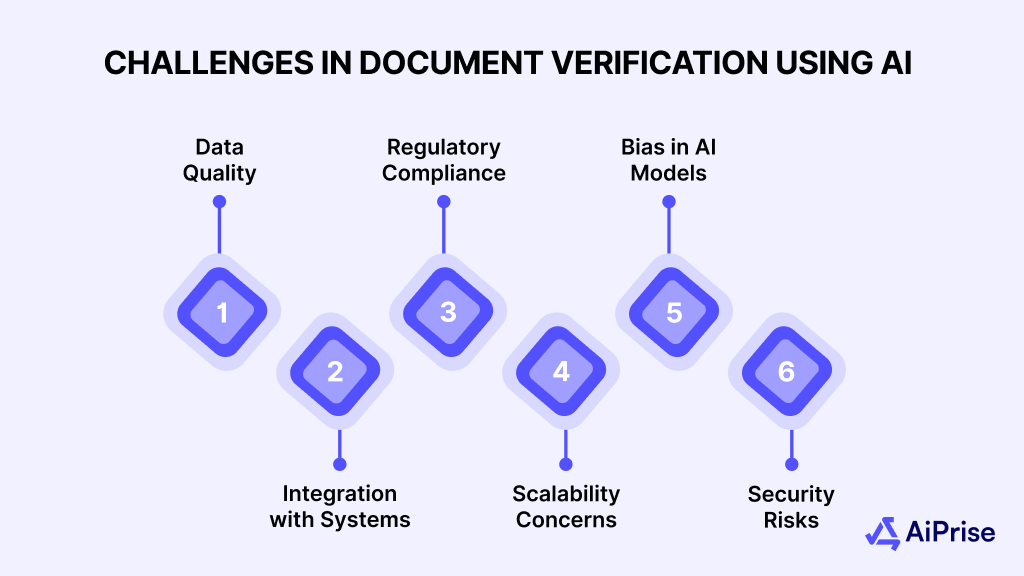
While AI document verification promises significant efficiency gains, organizations often encounter specific challenges during implementation and scaling. Identifying and addressing these hurdles proactively is crucial for seamless AI adoption and optimal system performance.
Here are the key challenges:
- Data Quality: Inaccurate or incomplete data can hinder AI’s ability to correctly validate documents, requiring constant data cleaning and validation efforts.
- Integration with Legacy Systems: AI verification tools may struggle to integrate with older systems, leading to compatibility issues and disruptions in existing workflows.
- Regulatory Compliance: Meeting complex regulatory standards, such as GDPR or CCPA, is essential when processing sensitive information, requiring thorough system checks.
- Scalability Concerns: As document volumes grow, AI systems may need further tuning to handle increased loads without sacrificing speed or accuracy.
- Bias in AI Models: AI systems can inherit biases from training data, which can affect the fairness and reliability of document verification, especially in diverse, multi-lingual contexts.
- Security Risks: AI verification systems are prone to cyberattacks, requiring robust encryption and security protocols to protect against data breaches.
Addressing the challenges in AI document verification is key to ensuring smooth and reliable operations. Implementing best practices can help mitigate these issues and optimise the verification process.
Best Practices for Document Verification Using AI
To handle challenges such as evolving fraud tactics, data privacy concerns, and system scalability, businesses must adopt practices that ensure both security and efficiency. By following the right strategies, businesses can enhance the accuracy and reliability of AI-powered document verification while minimizing risks.
- Adopt a Risk-Based Approach: Tailor verification methods to the risk level of each transaction. High-value transactions should trigger additional verification layers like multi-factor authentication (MFA) or biometric checks.
- Implement a Layered Security Model: Combine multiple security mechanisms such as biometric authentication, MFA, and device fingerprinting to ensure comprehensive protection and prevent breaches at different points.
- Regularly Update AI Models: Continuously train and update AI models with new data to improve fraud detection accuracy. This will help your system adapt to evolving fraud tactics and stay ahead of emerging threats like deepfakes.
- Ensure Compliance with Data Protection Regulations: Stay compliant with data privacy laws like HIPAA by implementing robust data encryption, secure storage, and transparent data processing practices.
- Monitor System Performance Continuously: Regularly review AI performance metrics to identify and resolve bottlenecks, ensuring that the verification process remains efficient even as document volumes increase.
- Provide User Education and Transparency: Inform users about the verification process and the security measures in place. Transparent communication increases user trust and reduces friction during verification.
Implementing best practices ensures that AI document verification remains effective and secure. Now, let’s look at real-world applications of AI document verification across various industries.
Real-World Applications of AI Document Verification
AI document verification is transforming operations across various sectors by automating the authentication process with speed and accuracy. From financial services to government, its real-world applications are enhancing security, reducing fraud, and boosting operational efficiency.
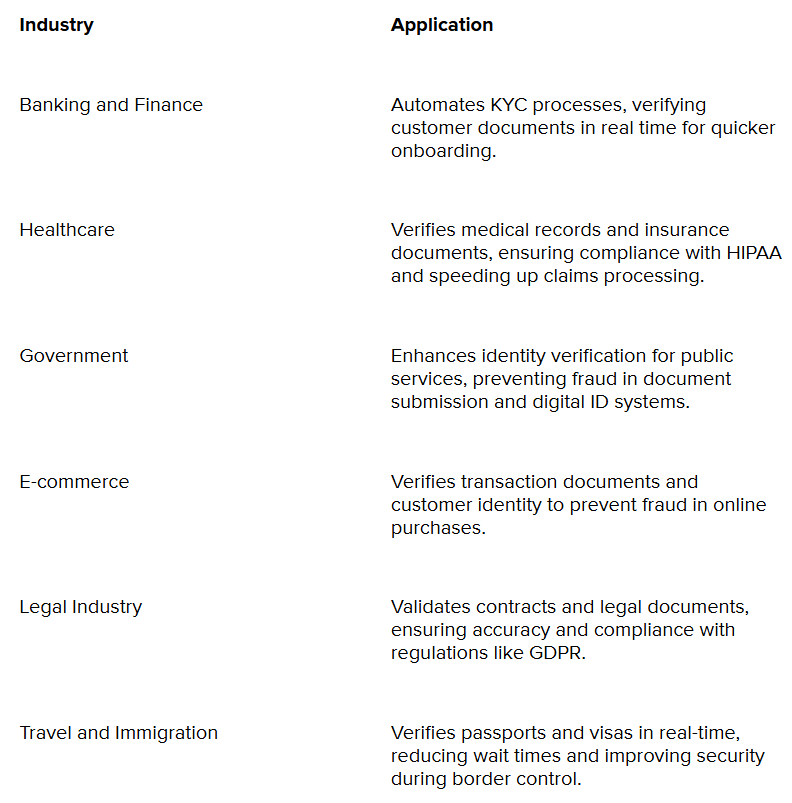
As AI document verification continues to transform industries, it’s important to look ahead at the evolving trends shaping its future.
What are the Future Trends in AI Document Verification?
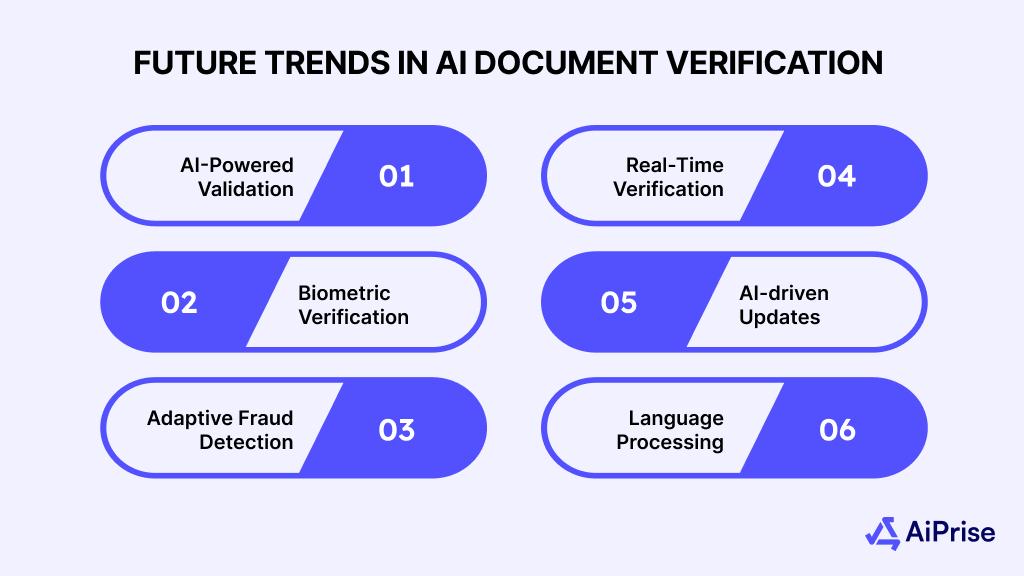
The landscape of AI document verification is continuously evolving, with exciting advancements poised to redefine accuracy, security, and efficiency. Explore the key innovations and emerging trends shaping its future:
- AI-Powered Validation with Blockchain: Integration of blockchain technology will ensure that documents are immutable and tamper-proof, allowing businesses to verify the authenticity of documents without relying on centralised databases.
- Advanced Biometric Verification: With the rise of Apple Face ID and Google’s DeepMind technology, AI will incorporate multi-modal biometric checks, including facial recognition and voice analysis, to enhance security.
- Machine Learning for Adaptive Fraud Detection: Platforms like FraudLabs Pro are pioneering fraud detection systems that use machine learning to identify emerging threats, enabling AI models to adapt and improve as new fraud tactics evolve.
- Real-Time Verification with Cloud Integration: AI-driven verification will integrate with cloud platforms such as Microsoft Azure and Google Cloud, enabling businesses to verify documents in real-time.
- AI-driven Regulatory Compliance Updates: AI systems will automatically adjust to the latest regulatory standards, such as CCPA, by utilizing RegTech solutions that update compliance requirements.
- Natural Language Processing (NLP) for Document Context: Leveraging NLP tools like OpenAI’s GPT-3, AI systems will improve their ability to understand and process complex documents, detecting context-specific discrepancies.
How AiPrise Helps in Document Verification Using AI?
AiPrise offers cutting-edge AI solutions for document verification, providing businesses with fast, secure, and accurate identity validation. Their platform simplifies compliance, mitigates fraud, and enhances operational efficiency by automating identity checks and adhering to global regulations.
- Global Document Verification: Verifies over 12,000 document types globally in under 30 seconds, assessing authenticity with Document Insights.
- Liveness Verification: Protects against deepfakes with proof of life checks to ensure the person is physically present.
- 1:N Face Match: Identifies and blocks duplicate users, preventing synthetic identities and fraudulent onboarding.
- Watchlist Screening: Automates screening against sanctions lists and PEPs, flagging high-risk entities instantly.
- Fraud & Risk Scoring: Uses AI to assess fraud risk and protect against digital threats.
- Step-Up KYC: Adapts verification intensity with a dynamic, risk-based approach for basic or enhanced checks.
- Case Management: Streamlines verification case tracking, reducing manual review time and improving operational efficiency.
Conclusion
Effective AI document verification goes beyond just meeting regulatory requirements; it plays a crucial role in enhancing security, reducing fraud, and streamlining operations. As businesses face growing challenges from evolving fraud tactics, utilizing AI-powered solutions ensures more accurate, faster, and secure document verification.
By investing in AI-driven verification, you not only protect your operations from risks but also build trust and improve customer experiences, driving long-term growth and efficiency.
Ready to optimise your KYC/AML processes? Protect your business from fraud and compliance risks with our AI-powered document verification solutions. Streamline workflows and ensure regulatory compliance with ease. Schedule a Demo with AiPrise today!
FAQs
1. How does AI improve the accuracy of document verification?
AI enhances accuracy by analyzing document structures, detecting inconsistencies, and identifying anomalies that human reviewers might miss. Machine learning models continuously learn from new data, improving their ability to spot sophisticated fraud.
2. Can AI handle various document types?
Yes, AI can process different documents like passports, IDs, and business registration papers. It adapts to various formats using OCR and machine learning. This ensures accurate verification across multiple document types.
3. How does AI-based verification ensure compliance?
AI streamlines compliance by automating identity checks and maintaining audit trails. It flags red flags like mismatched or expired documents. This ensures businesses stay compliant with regulations like KYC and AML.
4. Which industries benefit from AI document verification?
Banking, fintech, healthcare, and e-commerce benefit the most. These sectors deal with large volumes of sensitive data and require secure, efficient verification processes.
5. Is AI document verification secure and privacy-compliant?
Yes, AI systems use encryption and follow data protection laws. They can also be deployed on-premises, giving businesses full control over sensitive data.
You might want to read these...

Aiprise has helped streamline our KYB (Know Your Business) flow in 100+ countries. No other tool comes close.





Speed Up Your Compliance by 10x
Automate your compliance processes with AiPrise and focus on growing your business.





